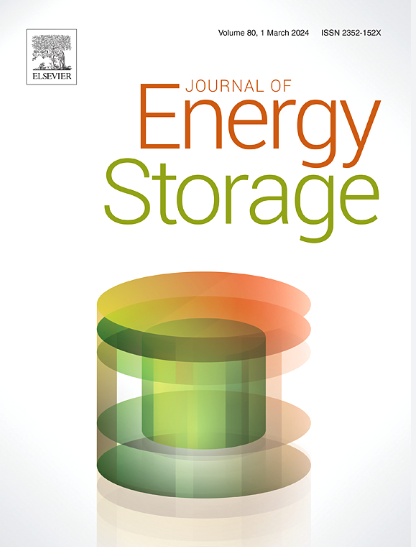PEDOT-MnO2/rV2O5@graphene基于纳米复合电极的可拉伸微型超级电容器阵列,具有t形接头切割基里格米结构
IF 8.9
2区 工程技术
Q1 ENERGY & FUELS
引用次数: 0
摘要
Kirigami结构被用来提高可穿戴智能电子产品中使用的平面功能电极的可拉伸性。然而,由于典型基里伽米结构的面外位移有限,电子性能较差,基于功能片的可拉伸器件的制备仍然具有挑战性。在这里,我们开发了高性能的二元金属氧化物纳米复合材料电极基微型超级电容器(MSCs)。为了实现抗外部机械应力的高拉伸非突出电极结构,采用t-节理切割基利格米结构和PEDOT-MnO2/rV2O5@GF纳米复合墨水制备了MSCs。我们证明了由3 × 4单元电池组成的可拉伸MSC阵列在0.208 A g−1时的比电容为25 F g−1,并且可以拉伸到20%的应变(在5000次拉伸/释放循环后保留76%的原始电容)而不会出现面外突出。因此,我们的具有t形接头切割基里伽米图案的MSC阵列可能是储能系统应用的潜在强大工具。本文章由计算机程序翻译,如有差异,请以英文原文为准。

PEDOT-MnO2/rV2O5@graphene nanocomposite electrode-based stretchable micro-supercapacitor array with T-joint-cut kirigami structure
Kirigami structure has been employed to improve the stretchability of a planar functional electrode used in the wearable smart electronics. However, the preparation of the functional sheet-based stretchable device is still challenging due to the limited out-of-plane displacement of the typical kirigami structure and poor electronic performance. Here, we developed the high-performance binary metal oxide nanocomposite electrode-based micro-supercapacitors (MSCs). As combinatorial enhancement strategies to realize highly stretchable non-protruding electrode structure against external mechanical stress, the T-joint-cut kirigami structure and PEDOT-MnO2/rV2O5@GF nanocomposite ink are used to fabricate the MSCs. We demonstrate that the stretchable MSC array composed of 3 × 4 unit cells exhibits the specific capacitance of 25 F g−1 at 0.208 A g−1 and can be stretched up to 20 % strain (76 % of original capacitance is retained after 5000 stretching/releasing cycles) without out-of-plane protrusions. Therefore, our MSC array with T-joint-cut kirigami pattern could be a potentially powerful tool for energy storage system applications.
求助全文
通过发布文献求助,成功后即可免费获取论文全文。
去求助
来源期刊

Journal of energy storage
Energy-Renewable Energy, Sustainability and the Environment
CiteScore
11.80
自引率
24.50%
发文量
2262
审稿时长
69 days
期刊介绍:
Journal of energy storage focusses on all aspects of energy storage, in particular systems integration, electric grid integration, modelling and analysis, novel energy storage technologies, sizing and management strategies, business models for operation of storage systems and energy storage developments worldwide.
 求助内容:
求助内容: 应助结果提醒方式:
应助结果提醒方式:


